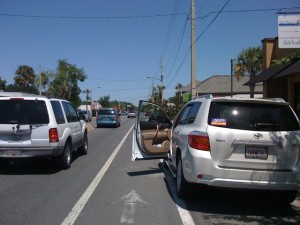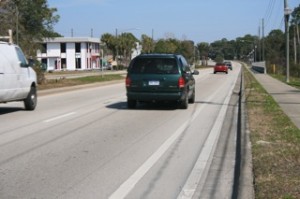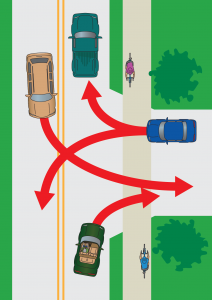“Biking in the middle of the lane like that sure looks dangerous.”
Driving in the middle of the lane actually protects cyclists against the most common motorist-caused crashes: sideswipes, right hooks, left crosses, and drive-outs. A bicycle driver’s top safety priority is to ensure he or she can be seen by motorists with whom they might potentially be in conflict, and bicycling in the middle of a lane is one of the most effective ways to do that. Most overtaking crashes involve a motorist who attempts to squeeze past (illegally) in a lane that is too narrow to share.

This is the width of a typical lane with vehicles drawn to scale. None of the above vehicles are able to give the required 3ft of passing clearance without changing lanes. A cyclist is far more likely to be sideswiped than run over.
“I thought bicyclists had to keep all the way to the right.”
While Florida law [FS316.2065-5] does say bicyclists must drive “as close as practicable to the right-hand curb or edge of the roadway,” it also provides many exceptions to this rule, including:
- When overtaking and passing another vehicle
- When traveling at or near the same speed as other traffic
- When preparing for a left turn
- Where a lane is too narrow to share safely with another vehicle
- To avoid any condition that makes it unsafe to continue along the right-hand curb or edge
Many surface hazards – such as potholes, puddles, debris, and broken glass – are more common near the edge of the roadway.
Keeping to the right can often hide a bicyclist from a turning motorist at the critical time and place. Check out this animation to see all the hazards a bicycle driver faces when trying to stay to the right.
“Why weren’t you in the bike lane?”

Anywhere in the bike lane a cyclist would be struck by this door. If the handlebar nicked the door, the cyclist would be thrown into the path of passing cars.

This is not a bike lane. It is two feet less than the minimum.
Most of the same reasons why bicyclists will drive towards the center of a lane are good reasons for leaving the bike lane, and Florida’s new mandatory bike lane use law allows cyclists the same exceptions as it does to keeping right in general. Here are just a few reasons:
- Bike lanes collect the debris and glass that is swept off the road. Sometimes you can see it because it’s big, like tree branches, but sometimes only we can see it. A small shard of glass can cause a flat tire. (How many tires did you change on your way to work today?)
- Many bike lanes are designed poorly or just plain dangerous. Bike lanes next to parked cars are often entirely within a hazard area we call “the door zone.” A suddenly-opened door can kill a cyclist.
- When approaching intersections, or in areas with lots of driveways, a bike lane puts us in a conflict zone (shown in the above animation). Bike lanes increase our risk for all of the common crossing and turning crashes.
- It may not be a bike lane. It has become popular to add edge lines several feet to the left of the curb. This space is substandard and not safe for a bicyclist to use, though many bicyclists are tricked into riding there.
Many of the reasons we avoid bike lanes are not visible or apparent to a person in a car. Of course, if a bike lane provides a clean, safe place to ride, we use it.
“Wouldn’t you just be safer biking on the sidewalk?”
While biking on the sidewalk would eliminate the very rare overtaking crash, it would increase the bicyclist’s risk for the far more common right hooks, left crosses, and drive-outs, and would make left turns far more complicated and less safe for the cyclist. Sidewalks present many more blind spots and physical hazards (such as poles, newspaper boxes, and intruding shrubs and tree limbs) than roadways do. If there’s a sidewalk on the left side of the road, but not the right side, cyclists would be traveling against the flow of traffic, which has been shown in traffic safety studies to increase the cyclist’s crash risk by a factor of four.
“You’re gonna get run over.”
Bicyclists across the nation who drive their bicycles in this manner have logged millions of miles without serious crashes or injuries. By comparison, bicyclists who hug the edge of the road, or ride on the sidewalk get into crashes much more frequently.
This video demonstrates why riding farther into the lane is not only safer for a cyclist, but creates less disruption for motorists.

No other road users impede traffic as frequently or severely as the drivers of private automobiles.
“You’re impeding traffic.”
All road users impede other road users on a routine basis. A motorist waiting to make a left turn from a two-lane street will impede motorists behind him. Transit buses stop to pick up and drop off passengers. Pedestrians in crosswalks impede motorists who are required to yield to them. Convenience must take a back seat to safety. In our training courses we teach cyclists how to minimize the delay they might cause to other road users, while still driving in the safest possible manner.
It’s rare for a bicyclist to cause more than 30 seconds of delay to passing motorists. On the other hand, traffic lights are often as long as a 1:30.
“You’re supposed to ride single-file.”
Florida law allows bicyclists to travel two-abreast, provided doing so does not impede traffic. On streets where the lane is not wide enough the share, a solo bicyclist is allowed to ride in the middle of the lane anyway, so the presence of another bicyclist to her right is of little consequence.
“Bicyclists don’t pay gas taxes, and shouldn’t be allowed on roads.”
Ah, where to begin… First, most bicyclists own and drive motor vehicles, buy gasoline for them, and therefore pay gas taxes. We all also pay gas taxes indirectly when pay for other goods and services; businesses pass along the costs of shipping and travel to customers.
But even if cyclists paid nothing, use of public rights-of-way is not contingent on payment of taxes. The Declaration of Independence does not say “all taxpayers are created equal,” but “all men are created equal” (meaning persons), and traveling along a public right-of-way is an essential liberty.
Many other taxes contribute to the construction and maintenance of public roads, including property taxes, sales taxes, impact fees, and more. Much of the gas tax is used to widen roads to accommodate more and more cars.
Gas taxes also go toward the construction of sidewalks along many roads. Using the same “don’t pay gas taxes” reasoning, school children should not be allowed to walk to school on sidewalks because they don’t pay gas taxes.
“Bicyclists should be required to have driver’s licenses.”
As with gas taxes, most do. But the reason people are required to be licensed to drive a motor vehicle is because they are inherently dangerous devices which pose a great danger to others. Motor vehicle drivers kill over 35,000 and injure over 2 million people a year in the United States. Careless or reckless motorists are a danger to everyone, while careless or reckless bicyclists are mostly a danger to themselves. If bicyclists should be required to be licensed, then so should pedestrians, as they pose about the same danger to others.
“Too many bicyclists think the laws don’t apply to them.”
We agree! We encourage and train bicyclists to drive their vehicles in the safest legal manner. Bicyclists who violate the law not only endanger themselves, but make those of us trying to do the right thing look bad. You can help us by calling the police (non-emergency number, please) when you see bicyclists doing the following: running red lights, blowing through stop signs, driving on the wrong side of the road (facing other traffic), and driving at night without front and rear lights. But please don’t call the police if you see one of us in the middle of the lane!





